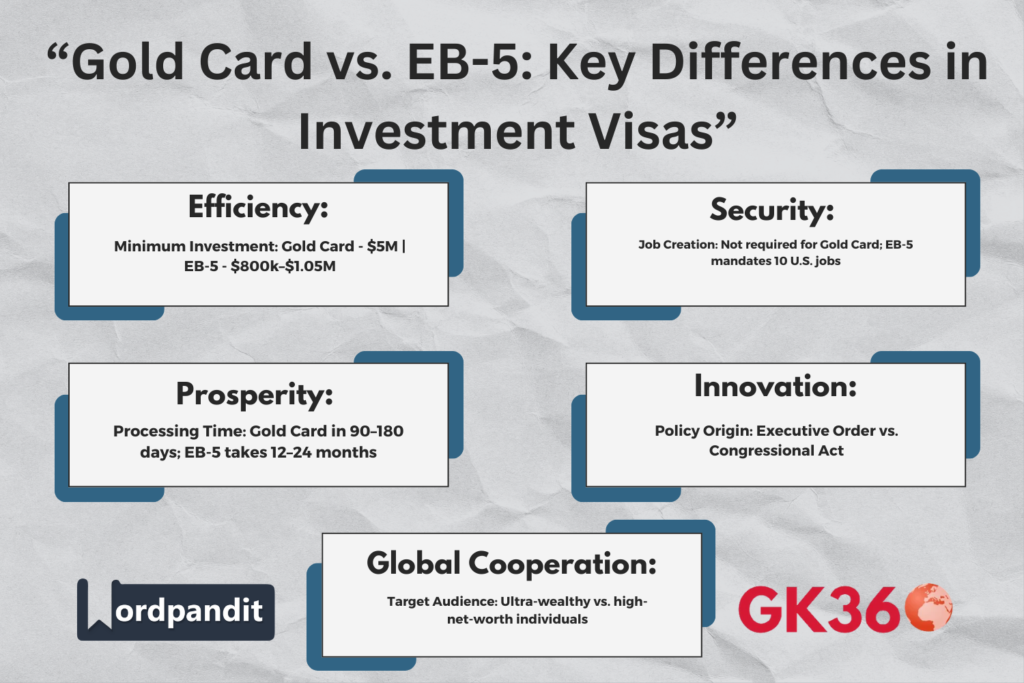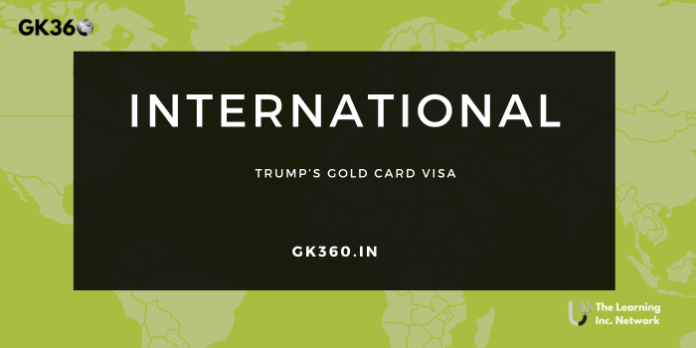Trump Gold Card Visa: $5M Investment Route to U.S. Residency & Citizenship
Introduction
In a bold move reshaping U.S. immigration policy, former President Donald Trump has unveiled the Gold Card Visa programme, a high-stakes initiative aimed at attracting global elites. Designed for ultra-wealthy investors, the programme offers a direct path to U.S. permanent residency—and possibly citizenship—through a $5 million investment. Announced at the high-profile “Building the Future” event in Washington, D.C., this policy is being pitched as a game-changer for both immigration and economic growth.
While it echoes the structure of the existing EB-5 investor visa, the Gold Card raises the bar, focusing solely on ultra-high-net-worth individuals. Trump’s team claims the visa will inject billions into the economy, boost job creation, and offer a new model for global investment migration. But critics warn that this sweeping move—bypassing Congress—could face significant legal and ethical scrutiny.

Table of Contents
- What Is the Gold Card Visa and Who Is It For?
- How to Apply for the Gold Card Investor Visa
- Comparing the Gold Card Visa and EB-5 Visa
- Economic Benefits and Investor Impact
- Legal Hurdles and Political Reactions
- The Future of U.S. Investment Immigration
- Frequently Asked Questions (FAQ)
- Conclusion and What to Watch Next
What Is the Gold Card Visa and Who Is It For?
The Gold Card Visa programme is a newly introduced U.S. residency pathway aimed at ultra-wealthy global investors. By investing $5 million into approved American enterprises or projects, foreign nationals can secure permanent residency with an option to transition toward citizenship.
Unlike typical green card avenues that focus on family ties, employment, or asylum, this visa is based purely on financial contribution. It’s designed to:
- Inject high-value capital into the U.S. economy
- Offer a fast-tracked route to legal residency
- Appeal to elite investors seeking global mobility and security
This visa is positioned as an upgrade over the traditional EB-5 programme, emphasizing speed, simplicity, and exclusivity.
How to Apply for the Gold Card Investor Visa
Eligibility Requirements
To qualify for the Gold Card Visa:
- You must invest a minimum of $5 million in a government-approved U.S. enterprise.
- The investment must support economic growth (e.g., infrastructure, tech, energy).
- Applicants must pass standard security and background checks.
- Funds must be legally sourced, with documentation to verify origin.
There is no requirement for job creation or regional targeting, unlike the EB-5 scheme.
Application Timeline and Platform
All application steps are centralized through the official portal: trumpcard.gov. The platform offers:
- Eligibility checklists and submission guides
- A dashboard for tracking progress
- Access to legal and financial documentation templates
Early reports suggest a streamlined review process, with residency approval possible in as little as 90–180 days, subject to background clearance.
Comparing the Gold Card Visa and EB-5 Visa
The Gold Card Visa draws comparisons to the existing EB-5 Immigrant Investor Program, but it introduces several critical distinctions:
| Feature | Gold Card Visa | EB-5 Visa |
|---|---|---|
| Minimum Investment | $5 million | $800,000 (TEA) or $1.05 million |
| Job Creation Requirement | None | Minimum 10 U.S. jobs |
| Processing Speed | Accelerated (90–180 days projected) | 12–24 months typical |
| Legislative Backing | Executive initiative | Created by Congress |
| Focus Group | Ultra-high-net-worth individuals | High-net-worth individuals |
While the EB-5 programme promotes inclusive development, the Gold Card is designed to target top-tier global capital. Critics argue this may exclude smaller investors and increase wealth-based migration inequality.
Economic Benefits and Investor Impact
Economic Stimulus Potential
Proponents argue that if just 10,000 applicants were approved, the Gold Card Visa could:
- Inject $50 billion into the U.S. economy
- Fund infrastructure, energy, and tech projects
- Create indirect employment via capital expansion
Investor Demographics
Initial traction is strong among elites from:
- Middle East (UAE, Saudi Arabia)
- China and Southeast Asia
- Wealthy diaspora communities
These investors view the programme as a gateway to:
- Global mobility
- Education access
- Business expansion in U.S. markets
Legal Hurdles and Political Reactions
Constitutional Concerns
Legal analysts have raised red flags. The U.S. Constitution assigns immigration policy to Congress—not the executive branch. Critics claim:
- The Gold Card Visa may bypass legislative approval
- It could be challenged in federal courts
- It might conflict with existing immigration statutes, like the EB-5 Act of 2022
Congressional Pushback
Several lawmakers, including immigration reform advocates, have questioned the programme’s:
- Transparency
- Economic equity
- Legality under U.S. federal immigration law
Trump Administration’s Position
Despite backlash, the administration argues:
- This is an economic tool, not a legislative overhaul
- The revenue from the visa could reduce national debt
- Executive action is warranted for economic emergency responses
The Future of U.S. Investment Immigration
Coexistence or Competition?
With the EB-5 programme reauthorized through 2027, analysts predict:
- A dual-tier investor migration framework
- EB-5 for medium-level investors
- Gold Card Visa for super-rich investors
Risks and Reforms
Potential issues:
- Risk of abuse or money laundering, as seen in early EB-5 history
- Public backlash over elite-only immigration
- Calls for congressional oversight and reform of investor pathways
Global Trend Alignment
The U.S. is not alone—similar visas exist in:
- Portugal (Golden Visa)
- UK (Tier 1 Investor Visa, now closed)
- UAE (10-year Golden Visa)
The Gold Card visa could position the U.S. to compete globally for top-tier investment capital.

Frequently Asked Questions (FAQ)
- Is the Gold Card Visa officially legal?
It is an executive initiative, not passed through Congress. Legal challenges are expected. - Does the visa guarantee U.S. citizenship?
No. It offers permanent residency first. Citizenship requires a separate naturalization process. - Is the EB-5 visa being replaced?
Not legally. EB-5 is reauthorized and remains active until 2027. - Who qualifies for the Gold Card Visa?
Foreign nationals with at least $5 million in legally sourced capital to invest. - Where can I apply for the Gold Card Visa?
Visit the official portal: trumpcard.gov for application guidelines.
Conclusion and What to Watch Next
The Gold Card Visa marks a major shift in U.S. immigration strategy—one that prioritizes economic capital over traditional qualifications. Whether this initiative becomes a cornerstone of modern immigration or gets blocked in courts depends on legal viability and public sentiment.
With the EB-5 programme still in place, investors now face a choice: inclusive, job-based investment via EB-5, or fast-tracked elite access via the Gold Card.
As the debate unfolds, policymakers, lawyers, and global investors will be watching closely.
Key Takeaways Table
| Aspect | Details |
| Program Purpose | Attract ultra-wealthy investors with a direct path to U.S. residency through economic contribution. |
| Investment Requirement | $5 million into government-approved projects such as tech, infrastructure, and energy. |
| Eligibility Criteria | Must verify legal source of funds, pass background checks; no job creation needed. |
| Application Process | Apply via trumpcard.gov; includes dashboards and legal templates. |
| Comparison with EB-5 | Gold Card is faster, more exclusive, but lacks job creation mandate and Congressional approval. |
| Legal and Political Outlook | Faces scrutiny for bypassing Congress and potential constitutional challenges. |
| Global Impact | Targets elites from Middle East, Asia, and diaspora communities; aligns with global investor migration trends. |





